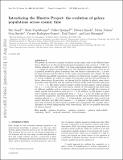Introducing the Illustris project: the evolution of galaxy populations across cosmic time
Author(s)
Genel, Shy; Vogelsberger, Mark; Springel, Volker; Sijacki, Debora; Nelson, Dylan; Snyder, Greg; Rodriguez-Gomez, Vicente; Torrey, Paul; Hernquist, Lars; ... Show more Show less
DownloadVogelsberger_Introducing the.pdf (10.15Mb)
OPEN_ACCESS_POLICY
Open Access Policy
Creative Commons Attribution-Noncommercial-Share Alike
Terms of use
Metadata
Show full item recordAbstract
We present an overview of galaxy evolution across cosmic time in the Illustris simulation. Illustris is an N-body/hydrodynamical simulation that evolves 2 × 1820[superscript 3] resolution elements in a (106.5 Mpc)[superscript 3] box from cosmological initial conditions down to z = 0 using the arepo moving-mesh code. The simulation uses a state-of-the-art set of physical models for galaxy formation that was tuned to reproduce the z = 0 stellar mass function and the history of the cosmic star formation rate density. We find that Illustris successfully reproduces a plethora of observations of galaxy populations at various redshifts, for which no tuning was performed, and provide predictions for future observations. In particular, we discuss (a) the buildup of galactic mass, showing stellar mass functions and the relations between stellar mass and halo mass from z = 7 to 0, (b) galaxy number density profiles around massive central galaxies out to z = 4, (c) the gas and total baryon content of both galaxies and their haloes for different redshifts, and as a function of mass and radius, and (d) the evolution of galaxy specific star formation rates up to z = 8. In addition, we (i) present a qualitative analysis of galaxy morphologies from z = 5 to 0, for the stellar as well as the gaseous components, and their appearance in Hubble Space Telescope mock observations, (ii) follow galaxies selected at z = 2 to their z = 0 descendants, and quantify their growth and merger histories, and (iii) track massive z = 0 galaxies to high redshift and study their joint evolution in star formation activity and compactness. We conclude with a discussion of several disagreements with observations, and lay out possible directions for future research.
Date issued
2014-09Department
Massachusetts Institute of Technology. Department of Physics; MIT Kavli Institute for Astrophysics and Space ResearchJournal
Monthly Notices of the Royal Astronomical Society
Publisher
Oxford University Press
Citation
Genel, S., M. Vogelsberger, V. Springel, D. Sijacki, D. Nelson, G. Snyder, V. Rodriguez-Gomez, P. Torrey, and L. Hernquist. “Introducing the Illustris Project: The Evolution of Galaxy Populations Across Cosmic Time.” Monthly Notices of the Royal Astronomical Society 445, no. 1 (September 22, 2014): 175–200.
Version: Author's final manuscript
ISSN
0035-8711
1365-2966